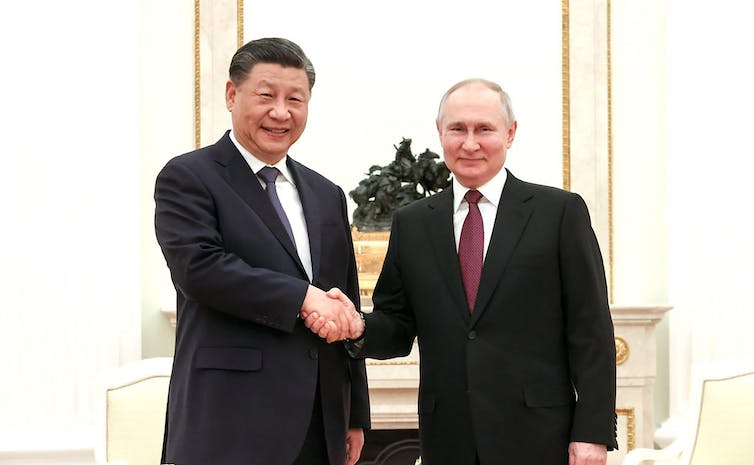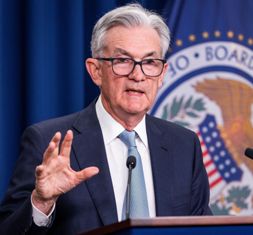Former US president George W Bush’s concept of an “axis of evil”, introduced in his 2002 State of the Union address, came to define the flawed foreign policy decisions of his years in power.
He used it to legitimise both the invasion of Iraq and the ensuing “war on terror”. Bush’s axis of evil included Iraq, Iran and North Korea. They were bound together as long-standing US adversaries, rendered as actively seeking weapons of mass destruction (WMD), and who, he argued, collectively posed a “grave and growing danger” as antagonist regimes capable of attacking the US and its allies.
Rolling into 2024, with a US presidential election on one side, and continuing geopolitical volatility from Ukraine to east Asia on the other, Republicans, in particular, have recently revived the term to explain concurrently the machinations of China, Russia, Iran and North Korea.
Clear and present danger?
The new “axis” however, operates on different principles, and its links to US policy are more tenuous.
First, the distinction between original axis countries, including long-standing US adversaries North Korea and Iran, and new additions China and Russia.
During the cold war, Russia and China were of great concern to the US. But during the Bush era, neither was regarded as constituting either the remote or proximate threat of that first axis. Grouping the four suggests that some in Washington feel that both China and Russia pose a significant enough challenge to both US and global systems to add them to a renewed axis of evil, rather than categorising them separately as individual belligerents.
Second, the perceived threat to the US arising from associations between each of the four members is uneven. Russia’s connections with Iran are long-standing and have been, mostly, tolerated by the US.
These links only become unpalatable, and worthy of including in an axis, when nations step over a particular line. Iran did so by helping Hamas plan the October 7 attack in Israel.
UPI/Alamy
Russia has been added to the axis list – after undertaking expansionist adventures so significant (by invading Ukraine) that it cannot be ignored. So for both Iran and Russia, magnitude of ambitions counts.
Neither Russia’s invasion of Georgia in 2008 nor Crimea in 2014 saw it consigned to a newfound axis of evil. It merely consolidated its status as a potential Eurasian rogue state.
It appears to be the risk of concerted collaboration between two or more axis members, and the combined threat that they represent that worries Washington. For example, former governor of South Carolina and presidential candidate Nikki Haley argued that “a win for Russia is a win for China”.
Third, the complexities of what the four have in common with each other remain unclear. What currently binds China and Russia together is their expansionist intent. But this differs from the historic willingness to stir up regional volatility exhibited by Iran and North Korea.
China stands opposed to such sabre-rattling from North Korea, while simultaneously undertaking plenty of its own regional expansion.
More interesting perhaps are the immense natural resources wielded by Russia and China, and to a lesser extent Iran. Russia and China make up enormous sections of Eurasia in terms of landmass, population and trading links binding their economies.
Does this suggest that the size, finances and natural resources of the new axis and its friends may allow it to become a semi-insulated trade and economic block? Probably not, but only while Russia’s current expansionist efforts remain at a standstill.
A post-conflict situation in Europe (assuming an end to the Ukraine war) will ultimately reset the sanctions regime against Russia, and – depending on Beijing’s peace-maker intentions – could facilitate warmer east-west relations.
Why revive the axis?
There are both drawbacks and benefits to resurrecting the idea of an “axis”. For supporters of the approach, the new axis provides policymakers with a convenient who’s who of adversaries. Assuming all four present a similar danger to the US, it gives a likely challenger for the presidency the chance to point at President Joe Biden’s foreign policy shortcomings.
While, unlike in Bush’s era, military interventions are probably not on the agenda, a more regionally targeted protectionist approach to “not try to do business with them” is more probable.
There is little of real value for US foreign policy in taking this approach. This uneven grab basket of anti-American villainy is reductivist at best, and cartoonish at worst. It suggests equivalences of power whether there are none, imagined ideological symmetry, and coordination incapable of surviving the short-term twists of four separate foreign policies.
The revival of the “axis” appears to be largely coming from Republicans, currently in charge of Congress, rather than the White House. But much may change in 2024 if they take over the presidency.
Like the original axis, the new grouping conflates power and ambition across states, muddies domestic objectives with regional support between two or more of the members, and suggests the need for a new global fistfight to defend democracy.
Rather than superficial attempts at suggesting basic enmity across four disparate nations, more important for the US ought to be a concern about Russia, China, Iran and North Korea’s long-standing preference for authoritarianism, and the ominous implications for their neighbouring states and regions. Alignment and agreements come and go. Entrenched authoritarianism, however, is hell to shift.




